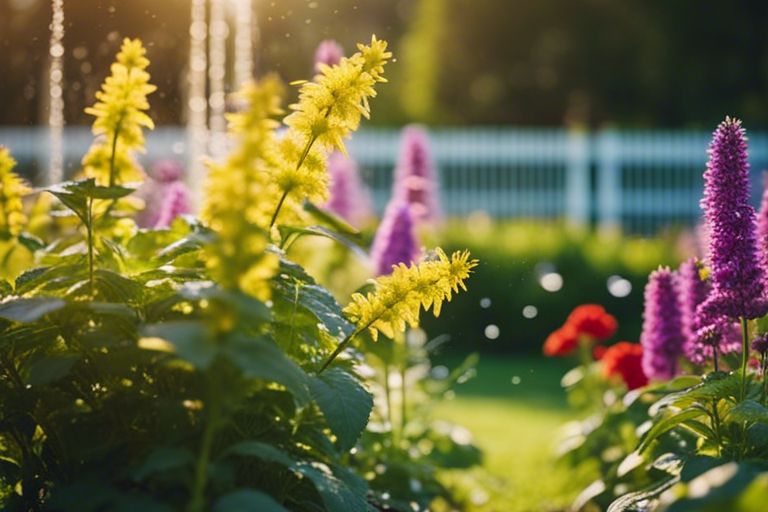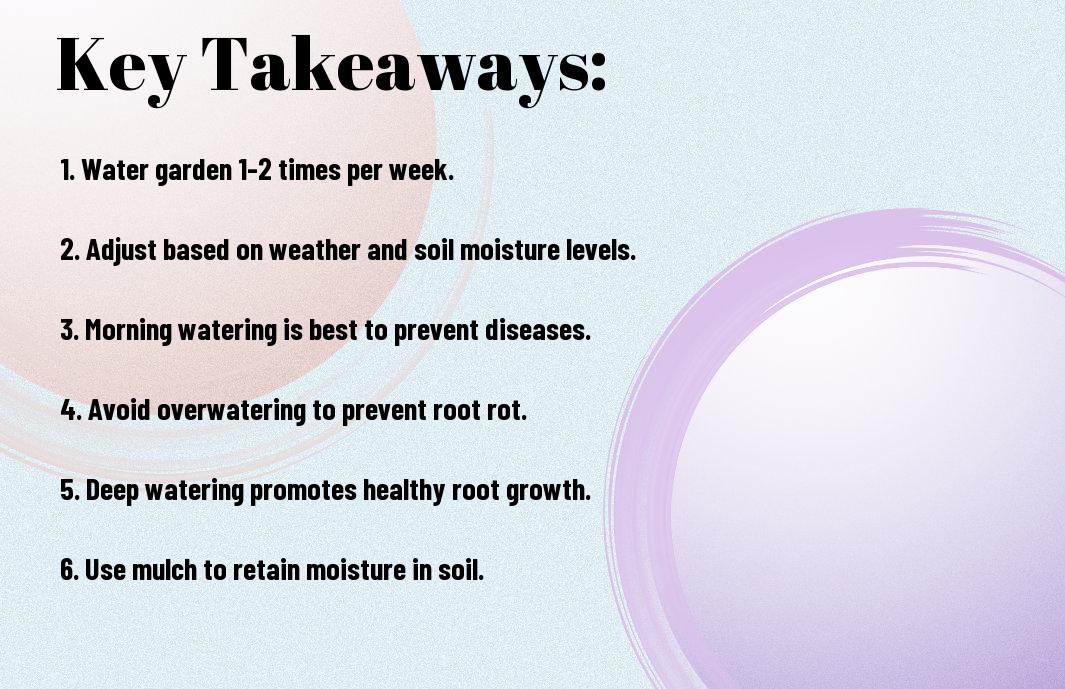Frequency plays a crucial role in the health and vitality of your garden. Determining the right watering schedule can be a bit of a balancing act, and it’s important to take into account factors like the type of plants, soil conditions, and weather patterns. In this guide, we will explore some key considerations to help you find the perfect watering routine for your garden, fostering a flourishing and thriving green space.
Key Takeaways:
- Check soil moisture: To determine how often to water your garden, check the soil moisture levels regularly. This can be done by sticking your finger into the soil about an inch deep to see if it feels dry or moist.
- Consider plant needs: Different plants have different water requirements, so it’s imperative to consider the specific needs of each plant in your garden. Some plants may need more frequent watering, while others are more drought-resistant.
- Water deeply and infrequently: It’s generally better to water your garden deeply and less frequently rather than shallow, frequent watering. Deep watering encourages strong root growth and helps plants become more resilient to drought conditions.

Factors Affecting Watering Frequency
For avid gardeners, understanding the factors that affect watering frequency is crucial to maintaining a healthy garden. Consider the following:
- Soil Type and Moisture Levels
- Climate and Weather Patterns
- Plant Types and Their Water Needs
The Soil Type and Moisture Levels play a significant role in determining how often you should water your garden. Factors such as soil composition, drainage, and moisture retention capacity can impact the frequency of watering. The key is to understand your soil type and monitor its moisture levels regularly.
Climate and Weather Patterns
Frequency
Climate and weather patterns also greatly influence the watering needs of your garden. In hot and dry climates, you may need to water more frequently to prevent the soil from drying out. Conversely, in cooler and wetter climates, you may need to adjust your watering schedule to avoid overwatering. Observing the weather forecast and adapting your watering routine accordingly is imperative for maintaining a thriving garden.
Soil
Soil that retains moisture well may require less frequent watering, while sandy or rocky soil may need more frequent watering to ensure that plants receive an adequate supply. Understanding how your soil interacts with water can help you establish a suitable watering schedule for your garden.
Identifying Signs of Underwatering and Overwatering
Wilting and Yellowing Leaves
The first sign that your garden may be underwatered is when you notice wilting and yellowing leaves. This is a clear indicator that your plants are not getting enough water to thrive. If you see this happening, it’s time to give your garden a good drink.
Cracked Soil and Waterlogged Areas
On the flip side, cracked soil and waterlogged areas are signs of overwatering in your garden. When soil becomes waterlogged, it deprives plants of oxygen, leading to their decline. Pay attention to these visual cues to adjust your watering schedule accordingly.
Leaves that are yellowing and dropping prematurely could also be a sign of overwatering. Excess water can lead to root rot, which in turn affects the overall health of your plants. It’s important to strike a balance and ensure your garden gets just the right amount of water it needs to thrive.
Overwatering can lead to the drowning of plant roots and create a hospitable environment for root diseases. It’s important to let the soil dry out between waterings to avoid this issue. Keep an eye out for these signs to ensure your garden is getting the proper hydration it needs to flourish.
Watering Strategies for Different Plants
Vegetables and Fruits
Not all plants have the same watering needs. Strategies for watering vegetables and fruits are crucial to ensure a bountiful harvest. Water deeply but less frequently to encourage strong root growth. Keep the soil consistently moist, especially during hot weather, to support fruit development. Mulching can help retain moisture and reduce evaporation, promoting healthier plants.
Flowers and Ornamental Plants
Strategies for watering flowers and ornamental plants differ from vegetables. These plants often require more frequent watering, especially potted varieties and those in direct sunlight. Monitor the soil moisture regularly and adjust watering based on the plant’s specific needs. Adding a layer of mulch can help retain moisture and regulate soil temperature for optimal growth.
Another tip for watering flowers and ornamental plants is to water at the base of the plants to avoid wetting the foliage. Wet leaves can invite diseases and pests, so a targeted watering approach can help maintain plant health.

Summing up
With these considerations in mind, the frequency of watering your garden ultimately depends on various factors such as the type of plants, soil type, weather conditions, and the time of year. By observing your garden, conducting a soil moisture test, and adjusting your watering routine accordingly, you can ensure your garden thrives and remains healthy throughout the growing season.
FAQ
Q: How often should I water my garden?
A: The frequency of watering your garden depends on various factors such as the type of plants, soil condition, weather, and time of year. In general, most gardens require around 1 inch of water per week, either through rainfall or manual watering.
Q: What signs should I look for to know if my garden needs watering?
A: Keep an eye out for signs of wilting, dry or yellowing leaves, and soil that feels dry to the touch. These are indications that your plants are thirsty and need a good drink.
Q: Should I water my garden in the morning or evening?
A: It is generally recommended to water your garden in the morning. This allows the plants to absorb the water before the heat of the day evaporates it. Watering in the evening can create excess moisture on leaves, which may lead to fungal diseases.
Q: How can I determine if I have watered my garden enough?
A: To check if your garden has received enough water, dig a few inches into the soil after watering. The soil should be moist, but not waterlogged. Adjust your watering schedule accordingly based on the soil moisture level.
Q: Are there any water-saving tips I can use in my garden?
A: Yes! You can conserve water in your garden by using mulch to retain soil moisture, watering at the plant’s base instead of overhead, and utilizing a drip irrigation system for targeted watering. Additionally, grouping plants with similar watering needs together can help optimize water usage in your garden.
